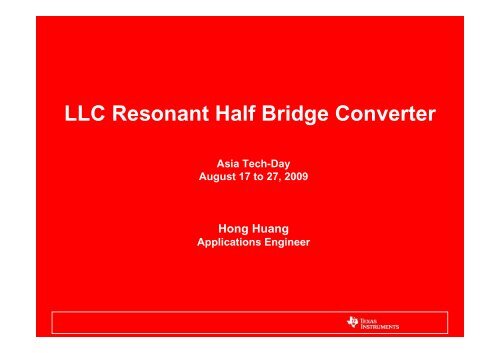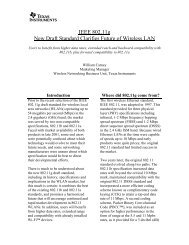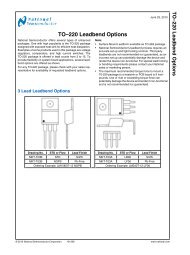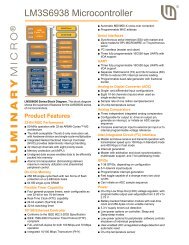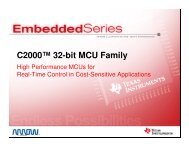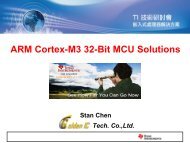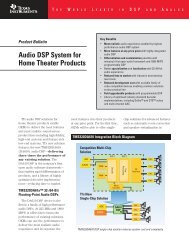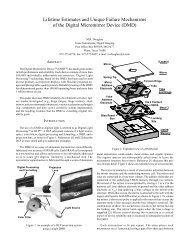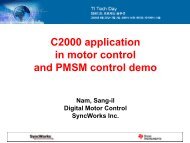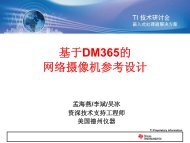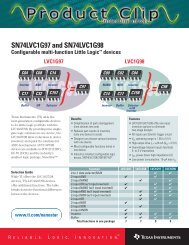LLC Resonant Half Bridge Converter
LLC Resonant Half Bridge Converter
LLC Resonant Half Bridge Converter
You also want an ePaper? Increase the reach of your titles
YUMPU automatically turns print PDFs into web optimized ePapers that Google loves.
<strong>LLC</strong> <strong>Resonant</strong> <strong>Half</strong> <strong>Bridge</strong> <strong>Converter</strong><br />
Asia Tech-Day<br />
August 17 to 27, 2009<br />
Hong Huang<br />
Applications Engineer
Outline<br />
• Introduction to <strong>LLC</strong> resonant half bridge converter<br />
– Benefits<br />
– Operation principle<br />
– Design challenges<br />
• Design method<br />
– Transformer turns ratio selection<br />
– Magnetizing inductor selection<br />
– <strong>Resonant</strong> component selection<br />
• Other design issues for <strong>LLC</strong> resonant converter<br />
– Current limiting<br />
– Soft start<br />
– OVP and Burst Operation
Design Challenges for DC/DC<br />
• Higher power conversion performance<br />
– Higher efficiency, smaller heat sink<br />
– Higher switching frequency, smaller magnetics<br />
– Less energy storage capacitors, smaller size (e.g., for PFC holdup)<br />
– Moderate frequency variations<br />
• Wide input voltage variations<br />
– AC-DC applications: holdup time requirement (PFC from 400V to<br />
300V during holdup)<br />
• Larger Energy Storage Capacitor – high cost, large size, more<br />
space<br />
• <strong>Converter</strong> ability to tolerate the variations<br />
– DC-DC applications<br />
• Telecom, 36 to 75V (32V to 78V)<br />
• Some applications even asking 4:1 variations<br />
• Wide output voltage trimming
Benefits of <strong>LLC</strong> <strong>Resonant</strong> <strong>Converter</strong><br />
• ZVS can be achieved by utilizing transformer magnetizing inductor<br />
• Capacitor filter, less voltage stress on rectifiers<br />
• Smaller switching loss due to small turn off current<br />
• Variable switching frequency control, not sensitive to load change<br />
• Frequency variations can be designed narrower compared to SRC<br />
• Wide operation range without reducing normal operation efficiency
<strong>LLC</strong> <strong>Resonant</strong> <strong>Converter</strong> with Wide<br />
Operation Range<br />
<strong>Resonant</strong><br />
frequency<br />
f<br />
0 =<br />
2π<br />
1<br />
r r C L<br />
Square Wave Generator to<br />
excite <strong>Resonant</strong> Circuit<br />
Transformer<br />
turns-ratio<br />
Rectifier to get DC<br />
• f sw is set at resonant frequency at nominal input and output<br />
• f sw is adjusted by feedback loop at other operation conditions<br />
n<br />
Vin<br />
/ 2<br />
=<br />
V<br />
o
Operation Principles<br />
At <strong>Resonant</strong> Frequency<br />
Vg_Q1<br />
Vg_Q2<br />
Vp<br />
ir<br />
is<br />
im<br />
t0 t1 t2 t3 t4<br />
t<br />
t<br />
t<br />
t<br />
t<br />
Vp<br />
• Q2 and D2 ON, Q1 and D1 OFF<br />
• Magnetizing current in Lm, im<br />
• Cr resonates with Lr, ir<br />
• Cr and Lr deliver energy to output
Operation Principle<br />
Above <strong>Resonant</strong> Frequency<br />
Vg_Q1<br />
Vg_Q2<br />
Vp<br />
ir<br />
is<br />
im<br />
t0 t1 t2 t3<br />
Vp<br />
• When switching frequency is above<br />
resonant frequency, circuit behaves as<br />
SRC<br />
• Secondary current becomes CCM,<br />
reverse recovery loss increases
Operation Principle<br />
Below <strong>Resonant</strong> Frequency<br />
Vp<br />
• When switching frequency is below<br />
resonant frequency, magnetizing inductor<br />
begins to participate in resonant and<br />
increases voltage gain<br />
• Secondary diode becomes discontinuous
<strong>LLC</strong> <strong>Resonant</strong> <strong>Converter</strong> Gain Function<br />
V<br />
oe<br />
= V<br />
rms<br />
os,<br />
1 =<br />
π<br />
nV<br />
rms π<br />
IRe =<br />
Ios<br />
, 1 = ( Io<br />
) / n<br />
2 2<br />
2<br />
2<br />
o<br />
M<br />
=<br />
L<br />
n<br />
f<br />
2<br />
n<br />
+<br />
(<br />
f<br />
2<br />
n<br />
L<br />
n<br />
f<br />
−1)<br />
2<br />
n<br />
( 1 + jf L Q )<br />
n<br />
n<br />
e
<strong>LLC</strong> <strong>Resonant</strong> <strong>Converter</strong> with Wide<br />
Operation Range<br />
• Unity gain is reached at V r =(V Lr -V Cr )=0, where<br />
input voltage in phase with output voltage, and<br />
input voltage applies to load (R e ) directly<br />
Inductive Region,<br />
Ir lagging Vge<br />
Capacitive Region,<br />
Ir leading Vge<br />
Unity Gain, Vr=0<br />
Voe in phase with Vge
<strong>LLC</strong> <strong>Resonant</strong> <strong>Converter</strong> with Wide<br />
Operation Range<br />
Working regions (Modes)<br />
- Inductive Region, if resonant network current is lagging input voltage<br />
- Capacitive Region, if resonant network current is leading input voltage<br />
- Resistive Region, if resonant network current is in phase with input voltage<br />
(boundary to divide Inductive and capacitive, by let the imaginary part zero of<br />
the input impedance)<br />
- Unity gain happens at (V Lr -V Cr )=0, where input voltage in phase with output<br />
voltage, and input voltage applies to load (R e ) directly
<strong>LLC</strong> <strong>Resonant</strong> <strong>Converter</strong> with Wide<br />
Operation Range<br />
• Should operate in ZVS region (Inductive Region, I r lagging<br />
Vge)<br />
• Avoid ZCS region (Capacitive Region, Ir leading Vge)<br />
– Hard switching of half bridge switches<br />
– Reverse recovery losses in primary FET body diodes<br />
– Large spikes on switch node<br />
– Higher EMI levels<br />
– Frequency relationship reversed<br />
• Frequency increases as load increases
Gain Characteristics with Ln and Qe<br />
Q<br />
e<br />
=<br />
Gain<br />
Lr<br />
/ C<br />
R<br />
2<br />
1.8<br />
1.6<br />
1.4<br />
1.2<br />
1<br />
0.8<br />
0.6<br />
0.4<br />
0.2<br />
e<br />
r<br />
Q e is related to output load<br />
Q e Increasing with Load Current<br />
Qe=0.0<br />
Qe=0.2<br />
Qe=0.8<br />
Qe=1<br />
Qe=2<br />
Qe=10<br />
ZCS/ZVS<br />
0<br />
0.1 1<br />
fn, (Ln =1)<br />
10<br />
Qe increase with Ln constant (designed Lr, Cr, and operational RL),<br />
- Peak-gain becomes lower<br />
- Frequency at peak-gain moving to right<br />
- Better “frequency-selective<br />
R<br />
f<br />
f<br />
e<br />
0 =<br />
p<br />
f n =<br />
8<br />
= n 2<br />
π<br />
=<br />
2π<br />
f<br />
f0<br />
2<br />
R<br />
L<br />
1<br />
2π<br />
LrCr<br />
1<br />
( Lr<br />
+ Lm<br />
) Cr
Gain<br />
2<br />
1.8<br />
1.6<br />
1.4<br />
1.2<br />
1<br />
0.8<br />
0.6<br />
0.4<br />
0.2<br />
Impacts of Circuit Parameters<br />
0<br />
0.1 1 10<br />
fn, (Ln =1)<br />
L n =1<br />
Qe=0.1<br />
Qe=0.2<br />
Qe=0.5<br />
Qe=0.8<br />
Qe=1<br />
Qe=2<br />
Qe=5<br />
Qe=8<br />
Qe=10<br />
ZCS/ZVS<br />
Gain<br />
2<br />
1.8<br />
1.6<br />
1.4<br />
1.2<br />
1<br />
0.8<br />
0.6<br />
0.4<br />
0.2<br />
0<br />
0.1 1 10<br />
fn, (Ln =5)<br />
L n =5<br />
Qe=0.1<br />
Qe=0.2<br />
Qe=0.5<br />
Qe=0.8<br />
Qe=1<br />
Qe=2<br />
Qe=5<br />
Qe=8<br />
Qe=10<br />
ZCS/ZVS<br />
Gain<br />
2<br />
1.8<br />
1.6<br />
1.4<br />
1.2<br />
1<br />
0.8<br />
0.6<br />
0.4<br />
0.2<br />
L n =10<br />
Qe=0.1<br />
Qe=0.2<br />
Qe=0.5<br />
Qe=0.8<br />
Qe=1<br />
Qe=2<br />
Qe=5<br />
Qe=8<br />
Qe=10<br />
ZCS/ZVS<br />
0<br />
0.1 1<br />
fn<br />
10<br />
Gain Change with Ln and Qe<br />
- Ln increase with Qe constant (designed Lr, Cr, and operational RL),<br />
- flat,<br />
- magnitude shift-up,<br />
- frequency value at peak-gain moving towards more left,<br />
- less “frequency-selective”<br />
- wide frequency variation from no load to full load (more discussion later)<br />
Ln somewhere 3 to 5 look best balance between peak gain and frequency<br />
change – can be initially pick-up
<strong>LLC</strong> <strong>Resonant</strong> <strong>Converter</strong> Operation for<br />
design consideration<br />
• Operation/design with no load and minimum gain at a1<br />
• Operation /design with full load and maximum gain at a3<br />
• All gain curves cross at unity at f n =1, or f=f 0<br />
• Qe design consideration at Heavy load, OCP, Short Circuit
Design Goals for <strong>LLC</strong> <strong>Resonant</strong> <strong>Converter</strong><br />
• Minimize RMS current under normal operation condition<br />
• Ensure ZVS operation<br />
• Ensure desired operation range
Design Consideration -1: Primary RMS Current at Normal<br />
Operation<br />
I<br />
P,<br />
RMS<br />
= I<br />
FHA →<br />
r<br />
=<br />
I<br />
2<br />
m<br />
+ I<br />
⎛<br />
⎜ 2 2 nV<br />
⎜<br />
⎝<br />
π ωL<br />
O<br />
2<br />
Re<br />
m<br />
⎞<br />
⎟<br />
⎟<br />
⎠<br />
2<br />
=<br />
⎛<br />
⎜<br />
π<br />
+<br />
⎜<br />
⎝ 2 2<br />
2<br />
I ⎞ o ⎟<br />
n ⎟<br />
⎠<br />
• Primary current can be easily calculated<br />
from the phasor circuit<br />
• Primary side RMS current is summation<br />
of magnetizing current and load current<br />
• Larger Lm is better for less conduction<br />
losses
Design Consideration -2: Secondary winding RMS<br />
Current<br />
I<br />
I<br />
RMS _ S<br />
RMS _ S<br />
=<br />
( I<br />
= I<br />
Re<br />
π<br />
× n)<br />
/ 2 = Io<br />
⇒ I<br />
4 2<br />
π<br />
× n = Io<br />
⇒ I<br />
2 2<br />
Re<br />
peak _ S<br />
peak _ S<br />
π<br />
= I<br />
2<br />
π<br />
= I<br />
4<br />
center − tapped<br />
bridge<br />
• Secondary side current is the difference between resonant tank current<br />
and magnetizing current<br />
O<br />
,<br />
O<br />
,
Design Consideration -3: Zero Voltage Switching<br />
I m,peak<br />
1<br />
2 1<br />
( Lm + Lr<br />
) Im,<br />
peak ≥ ( 2C<br />
2<br />
2<br />
eq<br />
) V<br />
ZVS conditions:<br />
- Enough H-field energy to balance E-field Energy in less<br />
than half cycle<br />
- Enough time to make the energy conversion<br />
- Worst operation for ZVS,<br />
-V o,min , I m,peak becomes small<br />
-V in,max , more C eq energy needs to discharge<br />
2<br />
in<br />
m,<br />
peak<br />
I<br />
m , peak<br />
dead<br />
=<br />
nV<br />
L<br />
I × t ≥ 2C<br />
L<br />
m<br />
m<br />
o<br />
eq<br />
T × t<br />
≤<br />
16C<br />
T<br />
4<br />
V<br />
dead<br />
eq<br />
in
Trade-off Design of Dead Time<br />
Lm<br />
tdead<br />
Smaller turn off current<br />
Smaller magnetizing current<br />
Increase RMS current due to<br />
duty cycle loss<br />
L t<br />
m<br />
dead<br />
Larger magnetizing current<br />
Larger turn off loss
Trade-off Design of Dead Time<br />
Conduction loss<br />
Loss (%) (%)<br />
Total loss<br />
Switching loss<br />
Trade-off between the switching loss and conduction loss on a case of 100ns<br />
dead time
Peak Gains with Ln and Qe<br />
Initially select Ln in the range of 3 to 5 (gain curve not very flat and able to<br />
narrow down the frequency change while there is still enough gain)<br />
Find proper Qe to get enough peak gain
Design Flow Chart for <strong>LLC</strong> <strong>Resonant</strong> <strong>Converter</strong><br />
<strong>Converter</strong> Specifications<br />
choose an L n and Q e<br />
Check max gain<br />
against graph<br />
Vin<br />
n =<br />
2V<br />
Peak gain enough?<br />
8n<br />
2<br />
8 2<br />
Re = n R 2 L = 2<br />
π<br />
O<br />
Change L n and Q e<br />
No<br />
Yes<br />
V<br />
π P<br />
2<br />
o<br />
out<br />
L =<br />
m<br />
L<br />
n<br />
L<br />
Lr =<br />
2<br />
C<br />
r<br />
=<br />
Magnetizing Inductance<br />
r<br />
<strong>Resonant</strong> Inductor<br />
1<br />
( 2πf<br />
sw ) Cr<br />
2πQ<br />
<strong>Resonant</strong> Capacitor<br />
e<br />
1<br />
R<br />
e<br />
f<br />
sw<br />
Calculate Re
Design - Over Current Protection<br />
Required<br />
Gain<br />
During over load condition, check if the converter enters ZCS region<br />
Q =<br />
e<br />
Lr Cr<br />
R<br />
e<br />
Max load<br />
Overload?
Design - Soft start<br />
Soft start is achieved by frequency control
Design – OVP and Burst Operation<br />
• Secondary OVP<br />
• Feedback loop fault may cause<br />
output over voltage.<br />
• Slow loop response may also<br />
cause OVP.<br />
• Independent OVP circuit is<br />
needed.<br />
• Burst Operation<br />
• To cover no load operation, smaller Ln is needed which increases<br />
circulating (magnetizing) current, leading more conduction losses.<br />
• To reduce switching losses, ZVS is still needed at no load. This requires<br />
higher magnetizing current, too.<br />
• To maintain output regulation, burst operation at light load and no load is an<br />
alternative to balance switching losses and conduction losses.
Feedback Loop Design<br />
- Measure G m (jω)<br />
-Design Gc (jω) based on Gm (jω) measurement 10 100 1.10 3<br />
− 60<br />
60<br />
Gain (dB)<br />
G ( S)<br />
= K<br />
Gain (dB)<br />
60<br />
Gc() f<br />
c<br />
60<br />
40<br />
20<br />
0<br />
20<br />
40<br />
60<br />
40<br />
20<br />
0<br />
-20<br />
-40<br />
dc<br />
Gain of Type I Compensator<br />
10 f<br />
S<br />
+ 1<br />
C1×<br />
R2<br />
koptoS<br />
S × (<br />
+ 1)<br />
2π<br />
× f<br />
1.10 4<br />
p _ opto<br />
UCC25600 EVM Modulator Plot (Test)<br />
-60<br />
-180<br />
10 100 1000 10000 100000 1000000<br />
Frequency (Hz)<br />
1.10 5<br />
180<br />
120<br />
60<br />
0<br />
-60<br />
-120<br />
Phase (Deg)<br />
180<br />
180<br />
120<br />
60<br />
0<br />
60<br />
120<br />
θc() f<br />
1.10 6<br />
− 180<br />
180<br />
10 6
Summary<br />
• <strong>LLC</strong> resonant converter is able to achieve wide<br />
operation together with high efficiency<br />
• Due to low switching losses, <strong>LLC</strong> resonant converter is<br />
able to operate at high switching frequencies, while<br />
maintaining high efficiency<br />
• <strong>LLC</strong> resonant converter design needs to find a suitable<br />
magnetizing inductor to ensure small conduction losses<br />
and switching losses<br />
• By choosing a suitable Ln and Qe value, desired voltage<br />
gain can be achieved to input and output voltage variation<br />
range
UCC25600 <strong>Resonant</strong> <strong>Half</strong> <strong>Bridge</strong><br />
Controller<br />
• Complete system features<br />
– Programmable soft start<br />
– Programmable dead time<br />
– Programmable maximum/minimum switching frequency<br />
– 0.4A source, 0.8A sink driving capability<br />
– Simple ON/OFF control<br />
– Burst operation at light load condition<br />
• Precise timing control<br />
– 3% accuracy on minimum switching frequency setting with only external<br />
resistor<br />
– ±50ns matching on dead time<br />
– Soft start timer range from 1ms to 500ms<br />
• Complete protection functions<br />
– Two levels over current protection, auto recovery and latch off<br />
– Bias voltage UVLO and OV protection<br />
– Over temperature protection<br />
– Soft start enabled after all fault conditions<br />
• 8 pin SOIC package, simplifies design and layout
Application Circuit<br />
UCC25600<br />
Programmable dead time<br />
Frequency control with minimum/maximum frequency limiting<br />
Programmable soft start with on/off control<br />
Two level over current protection, auto-recovery and latch up<br />
Matching output with 50ns tolerance
Test based on EVM (UCC25600EVM)
Test with EVM: <strong>Resonant</strong> Tank<br />
Ch3: Lr Current<br />
Scale: 3.4A/div<br />
Primary Peak Current: 2.72A<br />
Secondary Peak Current (Nt=16.7):<br />
3.4A/div x 0.8div x 16.7 = 45.4A<br />
Load Current: 25A<br />
Io/Is = 25/45.4 =0.55<br />
Compare: half wave rectifier<br />
TP24<br />
TP6<br />
Q2 Vds<br />
TP2 TP13
Test with EVM: Ripple and Hiccup
Test with EVM: Freq and Feedback<br />
Frequency Variation Feedback Loop Bode Plots
Test with EVM: Efficiency and Load<br />
Regulation<br />
Efficiency Load Regulation
Thank You!


